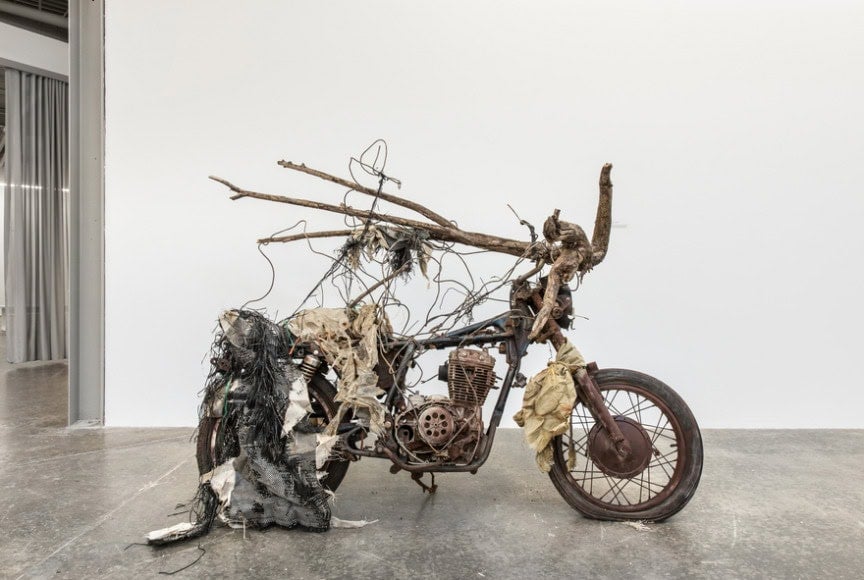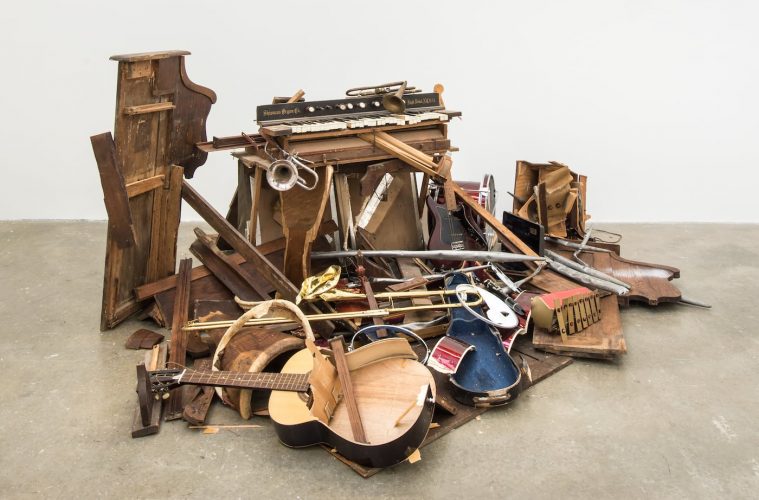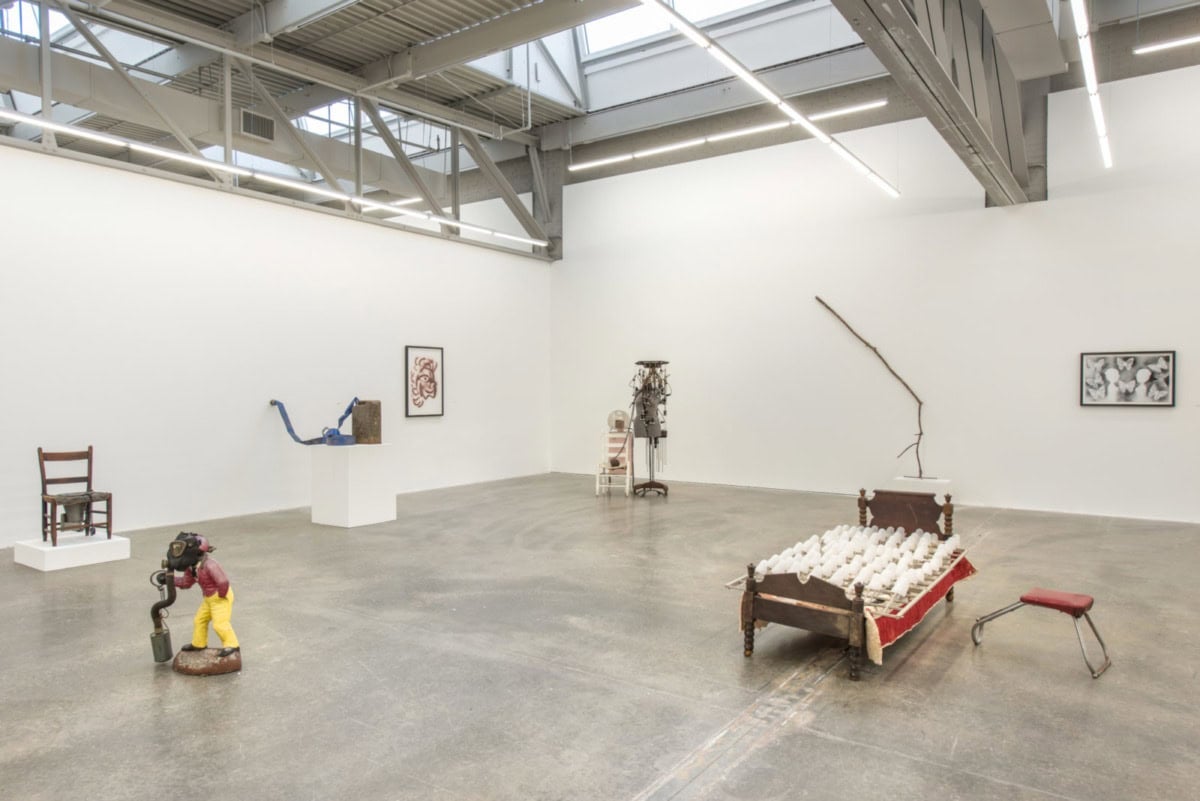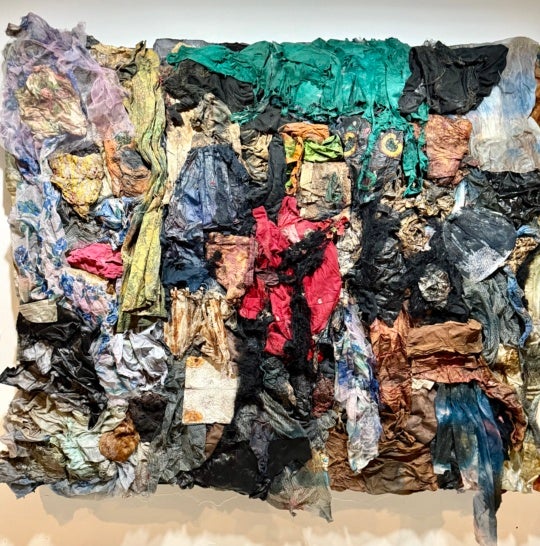
You hear the show before you see it. The sound of Lonnie Holley’s voice, emerging from behind a gauzy curtain, singing his own soulful blues against a polyrhythmic, almost hypnotic melody that seems driven by Afro-Caribbean beats. It forms the soundtrack against which his exhibition unfolds. With a title both direct and disarming, “I Snuck Off the Slave Ship”—on view at Atlanta Contemporary through April 2—is a study in Holley’s practice more than it is an historical examination of his process. A fixture on the Southern arts scene for decades, Holley’s national and international recognition is more recent. His exhibition at the Contemporary is tough, rough, delicate, and refined all at the same time. It is, rather unexpectedly, elegant—a word that is not often associated with the bricolage assemblages that Holley is best known for.
Holley’s exhibition, curated by Daniel Fuller, is at once a journey into the past and an assertion of the present, combining references to the artist’s history and newly created works. Beautifully installed, Holley’s pieces feel as if they have room to breathe, which imbues them with an additional layer of experiential life. They invite viewers to walk — within them, around them, between them — and to engage with them from multiple perspectives.
Holley does draw from his past, in such works as Moving to the Technical (2008), an assemblage of a telegram post, a muddle of wires, telephones, and other materials that symbolize communication. As Holley has observed, “We have become so dependent on the adoption of technology that we have allowed it to take over our lives.” But in pieces like this, Holley strikes at the heart of this conundrum, reflecting on what the detritus of that fetishization of technology really is. His use of already outdated material, including old phones and a boom box, highlights just how fleeting this junk truly is.
At times, Holley invites viewers into much more intimate physical and emotional spaces—an invitation shared through extended wall labels. In the label for Too Young for Lost Flowers (2008), he recounts how he came to art-making: “I started making art in 1979 when I lost a niece in a house fire . . .” That this heartbreaking revelation should be found, so unexpectedly, in a wall label is representative of Holley’s practice in general. His work is always wrapped up in something larger, something more significant, that is bounded by questions of race, location, and culture. It all stems from his childhood near Bessemer, Alabama, and an ongoing series of personal tragedies, including fires, one of which resulted in the loss of a loved one and another that destroyed a significant amount of his work.

If another soundtrack accompanied the exhibition, it might be played on the instrument fragments in After the Revival (Vox Humana III: The Strength of Music Lives After the Instruments are Destroyed). Here, the remains of an organ, a violin, a drum, and a trombone (at least among what is easily identifiable) provide the foundation for metaphors of loss and continuation. Again, as Holley remarks, “Our voices are still strong no matter how much people want to silence them.” That may be the sentiment of the work, but for the purposes of understanding the work’s context, his assertion that “I knew I wanted to keep destroying these organs” is more revealing. Read this psychoanalytically, and you may find find a great doubling of organ/organ, with the musical instrument standing in for the body. This is another key to understanding Holley’s works: that at their core, they are often metaphors he hopes will resonate with viewers with shared experiences.
Perhaps the most understated aspect of “I Snuck Off the Slave Ship” is its recurring use of the female profile. Holley returns again and again to this motif and the maternal figure. Given his difficult childhood filled with instability, beatings, and neglect, works such as Mother Teaching the Child the Old Praises of the Universe (2005) and My Roots Are in Me (2006) take on a sense of longing and, perhaps, solace. This same maternal motif also appears in his new large-scale steel sculptures From Within and The Seer.

In some pieces, Holley creates metaphorical spaces for viewers to “sit” and contemplate, such as Riding Through My Roots Too Fast (2004)—a motorcycle adorned with a tree branch, fabric, wires, and rope—and again in Growing Up Behind the Fence (2016), each time thwarting the invitation through an impediment that blocks the seat. About the latter, Holley even speaks of his sense of exclusion, telling a story of watching drive-in movies through the fence.
Perhaps what is left to consider is how Holley’s works play with the tensions that stereotypes and histories construct, whether it is a lawn jockey wearing a gas mask, or a voting booth with a handgun mounted near the voter’s head. Holley’s works become part chronicle and part commentary, with the chronicle situating each piece within a personal context, and the commentary creating complex and sometimes confrontational conversations that can’t be overlooked.
It may be best to end where the exhibition begins: in Disconnected, Holley lays out both the concept of the exhibition and the construct of our experiences in reaction to it. “When we were brought from Africa we were disconnected from our families. We’ve been disconnected in one way or another ever since.”
“I Snuck Off the Slave Ship” is, at its center, an attempt at reconnection. This is not altogether easy, because Holley’s works aren’t for everyone. His aesthetic is at times difficult to negotiate. Viewers have to make the same leap from trash to treasure that he does. But that doesn’t mean that it isn’t good. It just means that it takes time. Blow through in a few minutes and you might get some of it. Spend a little more time, and the works’ themes and metaphors emerge and deepen.




